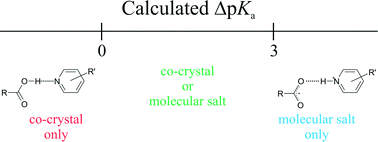Co-crystals and molecular salts of carboxylic acid/pyridine complexes: can calculated pKa's predict proton transfer? A case study of nine complexes†
Abstract
A series of nine complexes and 109 literature examples containing a carboxylic acid functional group and a pyridine functional group on separate molecules follow the ΔpKa rule such that proton transfer occurs at values above 3 to form a molecular salt and none at values below 0 to form a co-crystal. In the intermediate range, there is a predominance of molecular salt over co-crystal formation. The complexes discussed show that calculated pKa's are good predictors of the outcome.


 Please wait while we load your content...
Please wait while we load your content...